NATURE HAPPENINGS November 2013 |
|
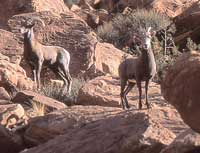 November starts the breeding season for desert bighorn sheep, although bachelor males may join groups of ewes, lambs and yearlings earlier in the fall. When things start to heat up during this season, older rams establish their dominance over younger rivals through posturing, chasing and body slamming. As older rams establish the hierarchy, the importance of their massive horns comes into play. If posturing doesn’t settle the dominance question, males engage in the classic head banging activity to determine who is “top ram.” At times, the resulting crash echoes off of the canyon wall like a rifle shot. November starts the breeding season for desert bighorn sheep, although bachelor males may join groups of ewes, lambs and yearlings earlier in the fall. When things start to heat up during this season, older rams establish their dominance over younger rivals through posturing, chasing and body slamming. As older rams establish the hierarchy, the importance of their massive horns comes into play. If posturing doesn’t settle the dominance question, males engage in the classic head banging activity to determine who is “top ram.” At times, the resulting crash echoes off of the canyon wall like a rifle shot.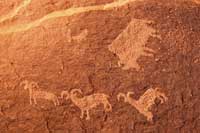 During the time of the Ancestral Puebloans, bighorn sheep roamed the canyons of southern Utah. Petroglyphs and pictographs of these magnificent animals grace many a canyon wall. Artifacts from the sheep include hides, ladles made from flattened horns, and bone tools. Of course, bighorn, mule deer and elk were consumed for their meat, along with jackrabbits and cottontails. During the time of the Ancestral Puebloans, bighorn sheep roamed the canyons of southern Utah. Petroglyphs and pictographs of these magnificent animals grace many a canyon wall. Artifacts from the sheep include hides, ladles made from flattened horns, and bone tools. Of course, bighorn, mule deer and elk were consumed for their meat, along with jackrabbits and cottontails.Suited for this rocky terrain, the desert bighorn has powerful leg muscles for scrambling up rocky slopes, sprinting across the rugged terrain or for leaping off ledges with unquestionable faith. In addition to their body strength, the sheep’s eyesight and acute hearing makes sneaking up on one a near impossible task. 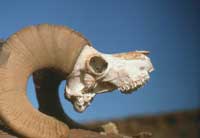 Both sexes have horns, although the males’ horns become massive and curled with age. Growth rings around the horns provides their age, each ring represents a year. Though the females also have horns, they are smaller and roughly the size of a yearling male’s horns. Both sexes have horns, although the males’ horns become massive and curled with age. Growth rings around the horns provides their age, each ring represents a year. Though the females also have horns, they are smaller and roughly the size of a yearling male’s horns.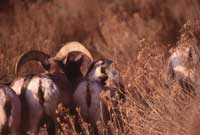 Unlike antlers which are shed each year, a desert bighorn’s horns are permanent. A sheath of keratin covers a bony core that is honey-combed with air chambers to reduce the overall weight, but maintains strength. The horns have a growth ring for each season which enables biologists to determine the sheep’s age. To truly appreciate the size and strength of these horns, one has to watch out for the autumn rut. Unlike antlers which are shed each year, a desert bighorn’s horns are permanent. A sheath of keratin covers a bony core that is honey-combed with air chambers to reduce the overall weight, but maintains strength. The horns have a growth ring for each season which enables biologists to determine the sheep’s age. To truly appreciate the size and strength of these horns, one has to watch out for the autumn rut.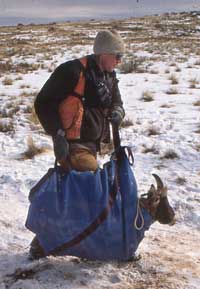 Periodically, the Utah Division of Wildlife Resources (UDWR) relocates sheep. These transplants are to either establish new herds or add to existing ones. Though bighorns were once widespread throughout Canyon Country, diseases spread from domestic sheep took a toll on wild populations. A recent relocation along the San Juan River will hopefully bolster herds in that area. Periodically, the Utah Division of Wildlife Resources (UDWR) relocates sheep. These transplants are to either establish new herds or add to existing ones. Though bighorns were once widespread throughout Canyon Country, diseases spread from domestic sheep took a toll on wild populations. A recent relocation along the San Juan River will hopefully bolster herds in that area. During November, these groups of bighorn are not as skittish as during the rest of the year. The sheep may be viewed from a distance without fear of them running away. Quiet observation often leads to some spectacular displays. Besides along the San Juan River, other good viewing areas are in Canyonlands National Park along the White Rim Trail, in Arches National Park near the park entrance, along Long Canyon off of the Potash Road, and in the basins below Dead Horse Point State Park. But for guaranteed sheep sightings along the Potash Road, keep an eye out for bighorn images etched on the canyon walls hundreds of years ago by the area’s native, sheep-watching inhabitants. |